بررسی تغییرات فشارهای ساکن و کارایی پروژه تزریق گاز در مخزن آسماری –پابده یکی از میادین جنوب غرب ایران با استفاده از نرم¬افزار ArcGIS
محورهای موضوعی : زمین شناسی نفتسید احسان ابراهیمی 1 , بهمن سلیمانی 2 *
1 - گروه زمین شناسی نفت و حوضه های رسوبی، دانشگاه شهید چمران اهواز، ایران
2 - استاد گروه زمين¬شناسي نفت و حوضه¬هاي رسوبي، دانشگاه شهيد چمران اهواز ،اهواز، ایران
کلید واژه: مخزن آسماری, بازیافت نفت, نقشه هیدرودینامیک, تزریق گاز, مکانیزم رانش, نرم افزار ArcGIS ,
چکیده مقاله :
یکی از مهمترین ویژگیهای مخزنی، فشار سیالات هیدروکربوری است که نقش بسیار مهمی در تولید روزانه و میزان بازیافت نهایی هیدروکربنها دارد. از اینرو اطلاع از تغییرات فشار هر میدان در طول زمان در مدیریت و توسعه مخزن اهمیت بسزایی دارد. در مطالعه کنونی از دادههای زیرسطحی مخزن آسماری-پابده در 30 حلقه چاه یکی از میادین نفتی جنوب غرب استفاده گردید. در این تحقيق دادههای زمینشناسی؛ پارامترهای پتروفیزیکی؛ سطوح تماس سیالات؛ تاریخچه تولید از مخزن؛ نقشههای هیدرودینامیکی؛ و نسبت گاز به نفت تولیدی (GOR) در محیط نرم افزارArcGIS، مورد بررسی قرار گرفت.
با استفاده از نرمافزار ArcGIS فشار نفت در سطح میدان و در طول زمان برای سالهای مختلف شامل دوره قبل و بعد از پروژه تزریق گاز، مورد بررسی قرار گرفت و مشخص شد که مخزن کربناته این میدان، دارای شکستگی فراوان است و با توجه به میزان شکستگیها، گسترش آنها و نیز تخلخل و تراوایی، نقاط مختلف میدان دارای ارتباط سیالی بسیار خوبی با هم بوده و فشار سیالات در کل میدان تقریبا یکنواخت و تغییرات جزیی دارد. با توجه به مکانیزم رانش طبیعی میدان، افت فشار حاصل از تولید شدید بوده اما کارایی پروژه تزریق گاز در آن موفقیتآمیز بوده به نحوی که در حفظ فشار و افزایش بازیافت نفت بسیار موثر عمل نموده است. نیروی هیدرودینامیک مهمترین عامل مکانیسم جابجایی سیال برای استحصال هیدروکربن بوده و از مکانیسمهای موثر با فاکتور بازیابی (Recovery Factor) بالاست. این نوع مطالعات میتواند ابزار مفید و قدرتمندی برای مدیریت تولید و توسعه و کنترل برداشت مخازن نفت و گاز باشد.
One of the most important characteristics of a reservoir is the pressure of hydrocarbon fluids, which plays a very important role in the daily production and the final recovery rate of hydrocarbons. Therefore, knowing the pressure changes of each field over time is very important in the management and development of the reservoir. In the present study, the subsurface data of Asmari-Pabdeh reservoir in 30 wells of one of the oil fields in the southwest were used. In this research, geological data; Petrophysical parameters; fluid contact surfaces; production history from the reservoir; drawing hydrodynamic maps; And the ratio of gas to oil production (GOR) was investigated in the ArcGIS software environment.
Using ArcGIS 9.2 software, the oil pressure on the surface of the field and over time for different years, including the period before and after the gas injection project, was investigated and it was concluded that the carbonate reservoir of this field has many fractures and with Paying attention to the amount of fractures, their expansion as well as porosity and permeability, different parts of the field have a very good fluid connection with each other, fluid pressure in the whole field is almost uniform and has minor changes. Due to the natural drift mechanism of the field, the pressure drop resulting from the production was severe, but the efficiency of the gas injection project was successful in a way that it has been very effective in maintaining the pressure and increasing oil recovery. Hydrodynamic force is the most important factor in the fluid displacement mechanism for hydrocarbon production and is one of the effective mechanisms with a high recovery factor. This type of studies can be a useful and powerful tool for managing the production and development and control of extraction of oil and gas reservoirs.

